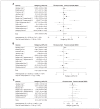Noninvasive brain stimulation in children and adults with attention-deficit/hyperactivity disorder: a systematic review and meta-analysis
- PMID: 33009906
- PMCID: PMC7955851
- DOI: 10.1503/jpn.190179
Noninvasive brain stimulation in children and adults with attention-deficit/hyperactivity disorder: a systematic review and meta-analysis
Abstract
Background: Repetitive transcranial magnetic stimulation (rTMS) or transcranial direct current stimulation (tDCS) could provide treatment alternatives to stimulant medication for attention-deficit/hyperactivity disorder (ADHD), given some evidence for improvements in cognition and clinical symptoms. However, despite a lack of solid evidence for their use, rTMS and tDCS are already offered clinically and commercially in ADHD. This systematic review and meta-analysis aimed to critically appraise rTMS and tDCS studies in ADHD to inform good research and clinical practice.
Methods: A systematic search (up to February 2019) identified 18 studies (rTMS 4, tDCS 14; 311 children and adults with ADHD) stimulating mainly the dorsolateral prefrontal cortex (dlPFC). We included 12 anodal tDCS studies (232 children and adults with ADHD) in 3 random-effects meta-analyses of cognitive measures of attention, inhibition and processing speed.
Results: The review of rTMS and tDCS showed positive effects in some functions but not others, and little evidence for clinical improvement. The meta-analyses of 1 to 5 sessions of anodal tDCS over mainly the left or bilateral dlPFC showed trend-level improvements in inhibition and processing speed, but not in attention.
Limitations: Heterogeneity in stimulation parameters, patient age and outcome measures limited the interpretation of findings.
Conclusion: The review and meta-analysis showed limited evidence that 1 to 5 sessions of rTMS and tDCS, mostly of the dlPFC, improved clinical or cognitive measures of ADHD. These findings did not support using rTMS or tDCS of the dlPFC as an alternative neurotherapy for ADHD as yet. Larger, multi-session stimulation studies identifying more optimal sites and stimulation parameters in combination with cognitive training could achieve larger effects.
© 2021 Joule Inc. or its licensors
Conflict of interest statement
No competing interests declared.
Figures



References
-
- American Psychiatric Association. Diagnostic and statistical manual of mental disorders. 4th ed. American Psychiatric Association; Washington (DC): 2000.
-
- Cazzoli D, Jung S, Nyffeler T, et al. The role of the right frontal eye field in overt visual attention deployment as assessed by free visual exploration. Neuropsychologia. 2015;74:37–41. - PubMed
-
- Noreika V, Falter CM, Rubia K. Timing deficits in attention-deficit/ hyperactivity disorder (ADHD): evidence from neurocognitive and neuroimaging studies. Neuropsychologia. 2013;51:235–66. - PubMed
-
- Coghill D, Toplak M, Rhodes S, et al. Cognitive functioning in ADHD: inhibition, memory, temporal discounting, decision-making, timing and reaction time variability. In: Banaschewski T, Coghill D, Zuddas A, editors. Oxford textbook of attention deficit hyperactivity disorder. chapter 10 Oxford, United Kingdom: Oxford University Press; 2018.
-
- Norman LJ, Carlisi C, Lukito S, et al. Structural and functional brain abnormalities in attention-deficit/hyperactivity disorder and obsessive-compulsive disorder: a comparative meta-analysis. JAMA Psychiatry. 2016;73:815–25. - PubMed
Publication types
MeSH terms
Grants and funding
LinkOut - more resources
Full Text Sources
Other Literature Sources
Medical
